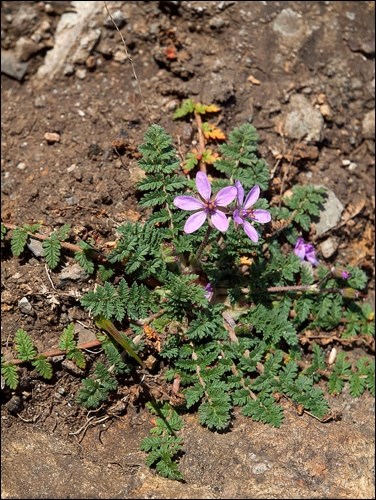Weeds rob your garden of moisture, nutrients and space, reproduce prolifically (some can produce up to 15,000 seeds per plant) and take advantage of your inattention. Weeds are opportunists and grow in waste space or on bare soil where there is little competition from other plants. Furthermore, weed seeds typically have high germination rates and can stay dormant in the soil for years making eradication nearly impossible.
Winter annual weeds are particularly tricky. They germinate in the late fall after you think you’re done for the year, continue to grow unchecked in cool weather until freeze-up and then start back up nearly as soon as the ground thaws to be ready to flower and set seed in early spring before any other plants have started growing – certainly long before you’ve even thought about putting out plants or sowing seed. Some winter annuals have a further trick. Over wintered and fresh seed can germinate in spring to then flower and set seed in time for fall germination.
Some winter annuals are easy to spot. They form a low rosette of leaves in the fall, stay green into the spring and then send up one to several flowering stems in early spring. Rosette-forming winter annuals include shepherd’s purse (Capsella bursa-pastoris), stinkweed (Thlaspi arvense) and stork’s-bill (Erodium cicutarium). Other winter annuals (by no means an exhaustive list here) include wild mustard (ball and dog mustards, Neslia paniculata and Erucastrum gallicum, respectively), flixweed (Descurainia sophia), narrow-leaved hawk’s-beard (Crepis tectorum), blueburr (Lappula echinata), common groundsel (Senecio vulgaris), chickweed (Stellaria media) and night-flowering catchfly (Silene noctiflora).
Controlling winter annuals is best done in late fall. If in a vegetable garden, run your rototiller through just before freeze-up. In your flower and shrub beds, pull by hand or use a small hand-hoe or trowel. Fortunately, many winter annuals have shallow fibrous roots or poorly developed tap roots, making removal easy. Furthermore, uprooted weeds are unlikely to survive over winter. Mulching your beds is an ounce of prevention that goes a long way. Mulch not only covers up the soil, preventing germinating weed seedlings from reaching the light of day, the surface of the mulch layer can be a poor location for seedlings.
If you didn’t get to them last fall, then now is absolutely the time for control. Essentially, most small green plants at this time of year are likely winter annual weeds. If they’ve already flowered, you should discard pulled weeds with your trash – do not compost. If they’re in your veggie garden, run your rototiller through as early in the season as possible. Unfortunately, uprooted weeds (even if badly mangled) in contact with soil have a bad habit of surviving long enough to produce seeds. So the fight may not be over (in truth, it never is with weeds).
Some winter annuals, like chickweed, can invade your lawn if given half a chance (e.g. you have a weak and patchy lawn), hand-pulling and rototilling are simply not practical options. So start with prevention. Maintain your lawn in as vigorous a state as possible with proper watering, fertilizer and mowing practices. This same strategy may also work for controlling minor incursions. But if chickweed has been allowed to become established, applying lawn weed-killer (e.g. multiple applications of triple threat 2,4-D, mecoprop plus dicamba) may be your only option.
— This column is provided courtesy of the Saskatchewan Perennial Society (www.saskperennial.ca; hortscene@yahoo.com). Check out our Bulletin Board or Calendar for upcoming garden information sessions: Labour & Learn (May 23); Plant Sale (May 23); Master Garden Workshop (May 23, 24); Friends of the Forestry Farm House walking tour and open house (May 24); Landscape design to nurture child development (May 26); SPS Plant and Seed Exchange (May 26).



